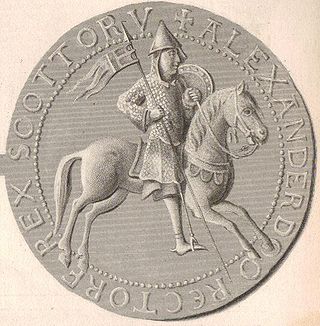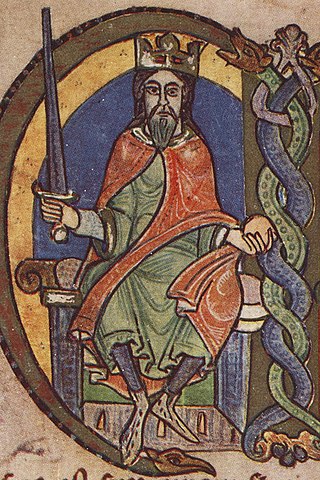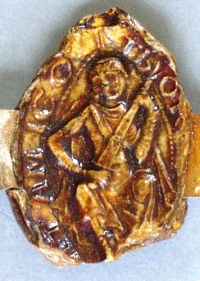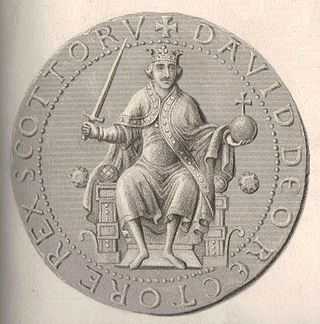Related Research Articles

Alexander I, posthumously nicknamed The Fierce, was the King of Alba (Scotland) from 1107 to his death. He was the fifth son of Malcolm III and his second wife, Margaret, daughter of Edward Ætheling, a prince of the pre-conquest English royal house.

David I or Dauíd mac Maíl Choluim was a 12th century ruler and saint who was Prince of the Cumbrians from 1113 to 1124 and later King of Scotland from 1124 to 1153. The youngest son of King Malcolm III and Queen Margaret, David spent most of his childhood in Scotland but was exiled to England temporarily in 1093. Perhaps after 1100, he became a dependent at the court of King Henry I of England, by whom he was influenced.

A royal burgh was a type of Scottish burgh which had been founded by, or subsequently granted, a royal charter. Although abolished by law in 1975, the term is still used by many former royal burghs.

Roxburghshire or the County of Roxburgh is a historic county and registration county in the Southern Uplands of Scotland. It borders Dumfriesshire to the west, Selkirkshire and Midlothian to the northwest, and Berwickshire to the north. To the southwest it borders Cumberland and to the southeast Northumberland, both in England.
Causantín or Constantine of Fife is the first man known for certain to have been Mormaer of Fife.
The MacHeths were a Celtic kindred who raised several rebellions against the kings of Scotland in the 12th and 13th centuries. Their origins have long been debated.
Fothad II was the bishop of St Andrews (1059–1093) for most of the reign of King Máel Coluim III mac Donnchada. Alternative spellings include Fodhoch, Fothach and Foderoch, and Fothawch. A "Modach filius Malmykel" is mentioned in a grant, dated 1093, as the bishop of S. Andrews. As this bishop is certainly Fothad II, his father was a man named Máel Míchéil.
Máel Dúin is the eighth alleged Bishop of St Andrews. He is mentioned in the bishop-lists of the 15th-century historians Walter Bower and Andrew of Wyntoun as the successor of Bishop Ailín.
Túathal is the ninth Bishop of St Andrews. He is mentioned in the bishop-list of the later medieval historian Walter Bower as the successor of Bishop Máel Dúin. Túathal's name, like his immediate predecessor Máel Dúin's, is known from other sources. A charter preserved in the Registrum of the Priory of St. Andrews, although probably translated into Latin from Gaelic at a later date, records a grant of the lands and church of Scoonie by Bishop Túathal (Tuadal) of St. Andrews to the Céli Dé of Loch Leven. Bower says that Túathal ruled as bishop for four years; as his successor Máel Dúin is known to have died in 1055, this would put his episcopate at roughly between the years 1055/6 and 1059/60. Túathal's immediate successor was the famous Bishop Fothad II.
Samson of Brechin is the first known Bishop of Brechin. He appears as a witness in a charter granted by King David I of Scotland to the community of Deer, recorded in the notitiae in the margins of the Book of Deer. The charter dates to some point between the years 1140 and 1153, although it can probably be pinned down to the year 1150. There certainly was a bishopric of Brechin in 1150, as there exists another charter of King David's, this time granted to the bishop (unnamed) and Céli Dé of Brechin. It is known that Samson was still bishop in the reign of King Máel Coluim IV (1153–1165), appearing as a witness as late as 1165 in a charter of Richard, Bishop of St. Andrews.
Gregoir of Moray [Giric, Gregory] is the first attested Bishop of Moray. His name occur in witness lists in two charters.

Thor Longus or Thor the Long was an early 12th-century Anglo-Saxon noble associated with Roxburghshire, a culturally Northumbrian and Brythonic Cumbric Celtic territory ruled by the Scottish king from the 11th-century onwards. A charter dating between 1107×1113 and 1124 claims that Thor the Long founded Ednam, previously a deserted waste granted to him by King Edgar of Scotland.

Before David I became the King of Scotland in 1124, he was the prince of the Cumbrians and earl of a great territory in the middle of England acquired by marriage. This period marks the beginning of his life as a great territorial lord. Circa 1113, the year in which King Henry I of England arranged his marriage to an English heiress and the year in which for the first time David can be found in possession of "Scottish" territory, marks the beginning of his rise to Scottish leadership.

Political and military events in Scotland during the reign of David I are the events which took place in Scotland during David I of Scotland's reign as King of Scots, from 1124 to 1153. When his brother Alexander I of Scotland died in 1124, David chose, with the backing of Henry I of England, to take the Kingdom of Alba for himself. David was forced to engage in warfare against his rival and nephew, Máel Coluim mac Alaxandair. Subduing the latter took David ten years, and involved the destruction of Óengus, mormaer of Moray. David's victory allowed him to expand his control over more distant regions theoretically part of the Kingdom. In this he was largely successful, although he failed to bring the Earldom of Orkney into his kingdom.

The relationship between the Kingdom of England and King David I, who was King of Scotland between 1124 and 1153, was partly shaped by David's relationship with the particular King of England, and partly by David's own ambition. David had a good relationship with and was an ally of Henry I of England, the King who was largely responsible for David's early career. After Henry's death, David upheld his support for his niece, the former Empress-consort, Matilda, and expanded his power in northern England in the process, despite his defeat at the Battle of the Standard in 1138.

The Davidian Revolution is a name given by many scholars to the changes which took place in the Kingdom of Scotland during the reign of David I (1124–1153). These included his foundation of burghs, implementation of the ideals of Gregorian Reform, foundation of monasteries, Normanisation of the Scottish government, and the introduction of feudalism through immigrant Norman and Anglo-Norman knights.
Edward [Ēadweard, Eadward, Édouard, Étbard] was a 12th-century prelate based in Scotland. He occurs in the records for the first time as Bishop of Aberdeen in a document datable to some point between 1147 and 1151. His immediate predecessor, as far as the records are concerned, was Bishop Nechtán. The latter can be shown to have been active at least between 1131 and 1132, and possibly as late as 1137. Edward's accession must have occurred, then, sometime between 1131 and 1151, with a date after the 1130s more likely than not.
William was a 12th-century prelate based in the Kingdom of Scotland. He occurs in the records for the first time as Bishop of Moray in 1152 x 24 May 1153, late in the reign of King David I of Scotland (1124–53) witnessing a grant from that monarch of the church of Clackmannan to the Abbot of Cambuskenneth. The precise date of his accession is unknown but was probably in 1152.
Thor of Tranent, also known as Thor, son of Sveinn or Thor, son of Swain, Lord of Tranent and Sheriff of Lothian, was a landlord and chieftain active in Lothian in the reign of King David I of Scotland. He is attested in a large number of charters during King David's reign in Lothian, both as a charter witness on charters granted by other patrons and on charters he himself issued. His name appears either as Thor son of Sveinn or "Thor of Tranent", the latter appellation deriving from his ownership of the "barony" of Tranent, East Lothian, lands including a wide area around the modern town, including, for instance, Prestonpans.

Cavers Castle, also known as Cavers House, is a ruined tower house located at Cavers, Scottish Borders, Scotland. Cavers Castle was a much extended tower house of the Douglas family dating back to the 15th or 16th century, and built upon the site of an earlier stronghold of the Balliols. It was repeatedly attacked during the 16th century wars with England, and substantially remodelled in the 17th century to form a mansion house, itself extended and remodelled in baronial style by Peddie and McKay in the 1890s. It was eventually deroofed and partially demolished in the 1950s, and was sold most recently in 2019. There are developing plans to restore the building, which is a listed building.
References
- Barrow, G. W. S., ed. (1999), The Charters of David I: The Written Acts of David King of Scots, 1124—53, and of his son Henry Earl of Northumberland, 1139—52, Woodbridge: Boydell Press, ISBN 0-85115-731-9
- Lawrie, Archibald Campbell, ed. (1905), Early Scottish Charters : Prior to A.D. 1153, Glasgow: J. MacLehose and sons
- Reid, Norman H.; Barrow, G. W. S., eds. (2002), The Sheriffs of Scotland : An Interim List to C.1306, St Andrews: University of St. Andrews Library [on behalf of] The Scottish Medievalists, ISBN 0-900897-17-1